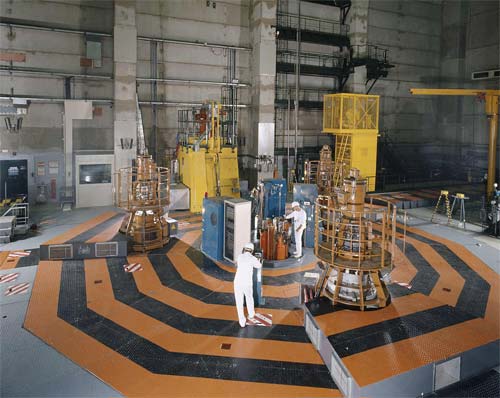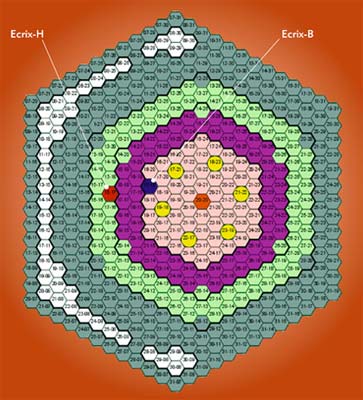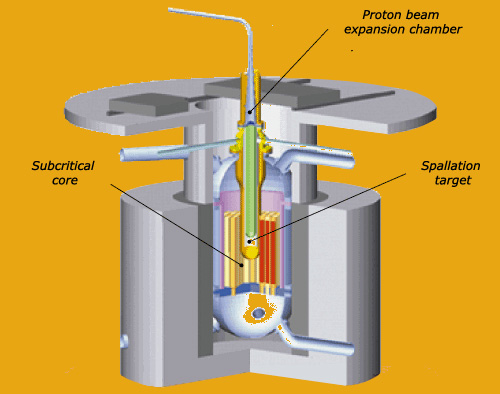Fast reactors and Accelerator Driven Systems (ADS)

PHENIX reactor hall
Located on the banks of the Rhône on the Marcoule nuclear site, PHENIX was a prototype sodium-cooled fast reactor. It first went critical in 1973 and supplied its first electricity to the grid in July 1974. The reactor’s thermal output was 580 MWth and it had a 250 MW turbine generator system. Major renovations were carried out in its last few years as a result of successive safety reviews. PHENIX was decommissioned in October 2009 after 36 years of faithful service.
© A.Gonin/CEA
The neutron, which easily penetrates nuclei, is the perfect tool for transmutation, but it takes a lot of neutrons to transmute waste. Nuclei are transmuted one by one but even the tiniest sample of material contains an almost infinite number. Only reactors are able to supply a sufficiently intense flow of neutrons. But when neutron capture is not followed by fission, actinides are generated, replacing those destroyed.
Transmutaion efficiency is generally low. For example, in a powerful reactor generating 1 GW of electricity, the neutrons only transmute 4.5% of the nuclear fuel into plutonium and fission products after three to four years of irradiation. Intense neutron fluxes are needed to enhance transmutation efficiency, together with high probabilities (known as cross-sections) of neutron capture by the nuclei to be transmuted.
Light water reactors (LWRs) are not very good for transmuting actinides because more neutron captures take place than fissions. Transmutation in pressurized water reactors (PWRs) has not shown much promise either. Compliance with safety regulations means that high efficiency levels cannot be achieved, even with special fuel. The multirecycling of americium on its own would require modifications to the reactor and the nuclear fuel cycle. This type of recycling cannot be done with the current reactor fleet.

Heterogeneous transmutation
The illustration shows two positions of americium targets within the PHENIX reactor core during a transmutation experiment (ECRIX) performed at Marcoule in 2005-2006. During this experiment, around 70% of the americium target was transmuted through fission. This transmutation rate was later increased to 94%.
© Clefs CEA N°46
In a fast neutron reactor the fuel tolerates larger proportions of minor actinides than in a PWR: 2.5 to 5% of the mass of the fuel compared with 1%. The feasibility of minor actinide transmutation in these fast reactors has now been established.
After SUPERPHENIX was decommissioned in 1998, PHENIX was one of the few fast neutron reactors (FNRs) in operation and the only one available in France. It was built in 1974 to produce electricity, was renovated and restarted for the transmutation research programme, and was decommissioned in 2010. At present France has no transmutation facilities.
In what form should radioelements for transmutation be inserted into a reactor core? New types of fuel have been designed to optimise transmutation performance. Two methods have been evaluated for introducing minor actinides into reactor cores: a homogeneous method, where the elements to be transmuted are distributed throughout the fuel, and a heterogeneous method where these elements are concentrated in special assembles. Fuels based on americium or other long-lived elements have been successfully inserted into reactors. The test programme will last until 2008.

Hybrid reactor demonstration facility
Reactors coupled with an accelerator could be used for incinerating radioactive waste. These hybrid systems combine a high-intensity proton accelerator (not shown in the figure), from which the protons enter the top left part of the reactor and generate fast neutrons, entering a subcritical fast neutron reactor. The possible use of these Accelerator Driven Systems or ADSs is still a long way off. The first demonstration facilities or prototypes such as the European MYRRHA project are envisaged for decades 2020-2030 at the earliest
© CEA
In principle ADS reactors controlled by an accelerator deliver better performance. Although FNRs are capable of burning their own actinides by recycling them, ADSs can burn a core consisting only of actinides.
There are many technological barriers to be lifted before these systems can see the light of day. European projects and research are currently in progress. The CNRS is actively involved in them, with the study of subcritical reactor cores (MUSE experiments), high-intensity proton injector (IPHI) projects, and targets for neutron production by spallation.
Learn more :
The MYRRHA facility (Multi-purpose hybrid research reactor)
Fast Breeder Reactors
Generation IV
Transmuting actinides
Other articles on the subject « Waste Outlooks »
Three research areas
Three complementary research areas The three research areas under the Bataille Act, later supplem[...]
Area 1: Partitioning
Sorting the radioelements in radioactive waste The separation, or partitioning, of the radioactiv[...]
Partitioning: results
Development of processes and extractant molecules The 2006 assessment of research into partitioni[...]
Advanced partitioning
Partitioning of nuclear waste: hot chemistry Advanced partitioning goes beyond just the partition[...]
Area 1: Transmutation
Area 1: Transmuting or transforming radioactive atoms Transmutation is the second part of researc[...]
Transmutation prospects
A far away objective for Generation IV and 2040… At the time of the first tests on the tran[...]
Area 2: Disposal
Research into deep geological disposal Can the nuclear industry’s final waste, which we cur[...]
Area 3: Long Surface Storage
Research into long-term storage Research into long-term storage is the second research topic in a[...]
Long surface storage concepts
Long-term surface and subsurface storage Research into very long-term storage is a matter for the[...]
Area 3: Conditioning
Area 3: Research into conditioning The conditioning of high-level and intermediate-level waste is[...]